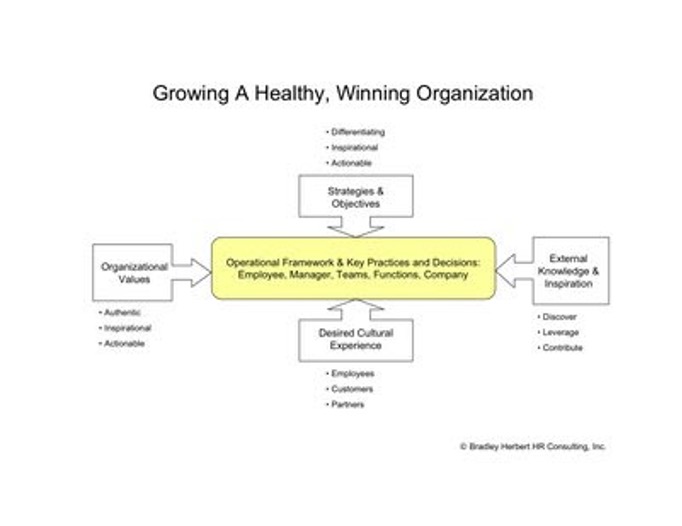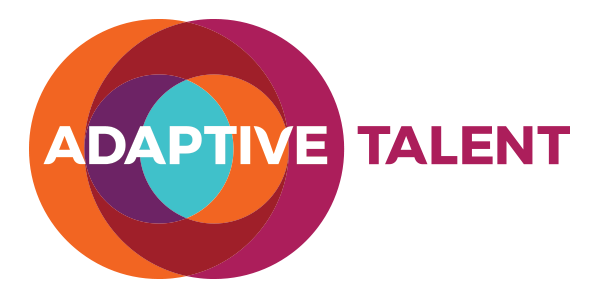
In the absence of an agreed upon approach, many leaders fall into the trap of addressing one issue after another, doing their best to remain true to their best judgment of how things should change. Leaders typically have an instinctual understanding of how they want things to change or, often, what they want to avoid, but struggle with communicating it in a way that works with a larger employee population. Without something concrete, recipients of these decisions are forced to place the individual decisions into a broader context and naturally each person is likely to do this slightly differently based on their experiences, preferences, roles, etc. As a result you end up with confused employees, conflicting practices and policies, and seemingly unclear priorities, or, as we’ve all experienced, the organizational equivalent of the awkward teenager years.
The leadership solution is understanding that evolving the organization requires constantly clarifying and balancing between four equally important inputs:
- Organizational Values
- Strategies & Objectives
- Desired Cultural Experience
- External Knowledge & Inspiration
These inputs should be reflected in how the organization manages itself (the operational framework), creates value (key processes and practices), and makes decisions at various levels: employees, managers, teams, functions, and company. Let me just highlight a few things on each input.
Values, for the most part, should be relatively unchanging if they’re authentic, inspirational, and actionable. If your values could easily be swapped with another organization, you need to work on them. They should feel unique and should be the way you want to live your life inside and outside of work. Otherwise, they’ll be some cheesy management tool that people mock. Take a look at my post on Zappos for an example of values that people take seriously and that permeate all aspects of the business (even the customers cite the Zappos values as reasons they enjoy shopping with them).
The desired cultural experience is how you want people to experience your organization at multiple levels: potential, past, and current employees, customers, and partners. Marketing people might call this your brand experience, but I think that often is defined too narrowly around product or service when in reality truly unique companies (think Apple Computer) have a vibe that transcends physical space (retail stores or headquarters) or single transactions (reading about Mac products, evangelizing them myself, hanging out in the retail stores, even considering working at Apple’s HQ). Leaders would be well served to think broadly about their organization’s purpose with stakeholders and then tune the way they run the organization to achieve that desired experience. As an example, Zappos sells shoes but it’s the place for people who LOVE shoe fashion to hang out online with other people who are completely into shoes. Zappos then makes money by facilitating that community and connecting those folks with the products they want. There’s a big difference between simply selling shoes and creating an experience for your customers, partners, and employees.
Strategies and objectives often do not exist or are too vague, either because the leaders are used to making quick decisions in the moment or they don’t know how to develop a clear strategy. When an organization is small this may not be a huge deal because people are likely physically close enough to each other that everyone knows what is going on and most functions have no more than a few people. However, as organizations grow, so too does the complexity and limits on execution so it’s imperative that leaders focus on providing clear strategies and translating those into actionable objectives across the organization. If you’re a leader with a growing business and find your work/life balance completely out of whack or are noticing more things falling through the cracks, chances are that you might need work in this area.
Lastly, external knowledge and inspiration is essential to remain competitive and for breakthrough thinking. Today’s technologies allow organizations to have a much tighter customer relationship allowing everything from input on decisions to real time assistance with product usage. Advances in technology and the ability to keep close tabs on the competition mean that competitive advantage is quickly matched, so it’s critical that organizations understand the most appropriate methods for acquiring, applying, and creating the knowledge that will give them a competitive advantage.
The middle section is how you operationalize the four forces and run the organization: key processes (product development, supply chain, marketing, sales), practices (approving new products, management transparency, talent management, rewards and recognition, etc.), and decisions. The individual decisions by themselves may or may not be significant, but the collection of those decisions end up acting as a shared mental model of life in your organization which impacts who wants to associate themselves with the organization, filters for behaviours, etc.
As organizations grow, so too will complexity and too often leaders underestimate the importance of investing in infrastructure, processes, comprehensive communications, training, and cross group work as a way of reducing barriers to growth. I’ve previously blogged about execution and the importance of an operational framework and encourage people to review what’s involved with translating strategy into objectives, etc. There is no right answer for how to run an organization, but following these simple guidelines will hopefully help leaders take a step back and ask how they’re managing their versions of the four forces.
I hope this has been helpful and of course the Adaptive Talent team would welcome the opportunity to help you and your team improve your results and adaptability via our culture and organizational development consulting, communications and coaching / mentoring training, total rewards consulting, assessments, leadership coaching and development programs and retained search to help you land high impact talent.

